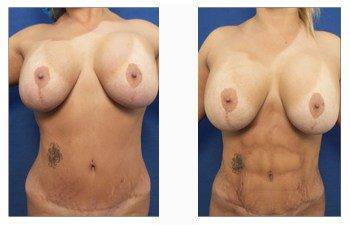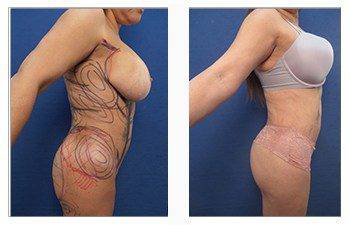

Please see this 46-year-old female who demonstrated a fibrotic operated look at two months but which resolved at the six-month mark.
In high-definition body contouring, it is critical to link fat excess treatment with skin redundancy evaluation. Removal of fat excess needs is performed while being mindful of not creating skin redundancy. In avoiding skin irregularities following high-definition body contouring, it must be observed fully for the patient’s benefit too.
As a trainer of surgeons for high-definition body liposuction, I routinely observe poor postoperative outcomes that involve the creation of skin irregularities.
Skin irregularities occur when too much fat is removed for the degree of skin redundancy. Intuitively, removing unwanted fat will only result in more skin redundancy.
As such, it is critical to identify and plan to cope with skin redundancy when present preoperatively. When redundant skin is not addressed, it will result in skin contour irregularities that will compromise your overall result. The reason for this is that redundant skin needs to settle evenly.
Despite our efforts to help the skin lay back down evenly by using compression garments and customized foam inlays, the skin wrinkles in uneven and operated-looking ways.
In addition, to the uneven laying down of the skin, redundant skin will firm up and look “woody” in appearance in the early postoperative period. This undesirable firming of the skin results during the pro-inflammatory phase of surgery that extends from one week to one month after surgery and involves the body’s influx of fibroblasts into the surgical field and their deposition of collagen molecules, i.e., scar tissue.
How to Avoid Skin Irregularities Following High-Definition Body Contouring
Several maneuvers are utilized to counter the pro-inflammatory phase. First, patients are placed on steroids, called Medrol dose packs, for five days immediately following surgery to block the pro-inflammatory phase responsible for attracting fibroblasts.
In addition, patients are placed on Accolate medication that counters scar tissue formation initially advocated to counter capsular contracture in breast implant augmentation cases.
More aggressive measures are taken postoperatively, starting as early as two weeks following surgery, with radiofrequency administered to break down collagen deposition, resulting in scar tissue buildup.
Topical radiofrequency is applied at ½ strength at two weeks, then ¾ dose at three weeks, and finally full dose at four weeks. Avoiding skin irregularities following high-definition body contouring Finally,
In summary, avoiding skin irregularities following high-definition body contouring requires a multi-modality effort. The most effective technique to counter the unwanted operated look is your surgical design that addresses skin redundancy either with a scar-less, minimally invasive Renuvion skin tightening tool or a more aggressive excision of skin, mini tucking procedure, done simultaneously with liposuction.
The second measure utilizes anti-inflammatory measures to counter the pro-inflammatory phase of healing using the Medrol dose pack and Accolade.
The final effort requires using postoperative modalities that will help break down any undue collagen that will create scar tissue. When all of the measures are taken, successful contouring can be achieved without the effects of an operated look.

